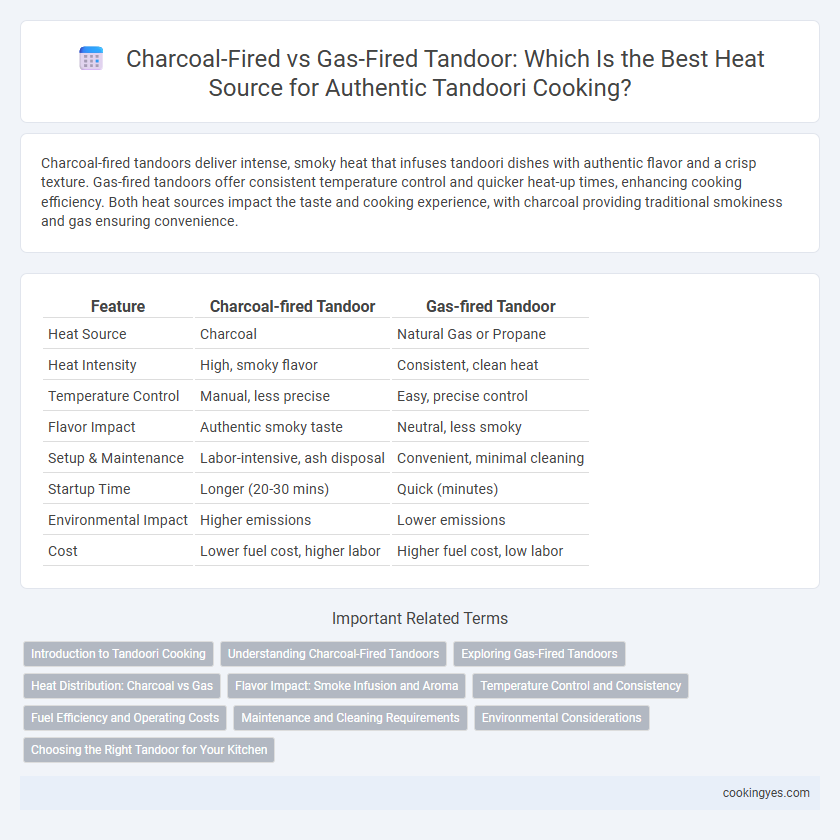Charcoal-fired tandoors deliver intense, smoky heat that infuses tandoori dishes with authentic flavor and a crisp texture. Gas-fired tandoors offer consistent temperature control and quicker heat-up times, enhancing cooking efficiency. Both heat sources impact the taste and cooking experience, with charcoal providing traditional smokiness and gas ensuring convenience.
Table of Comparison
| Feature | Charcoal-fired Tandoor | Gas-fired Tandoor |
|---|---|---|
| Heat Source | Charcoal | Natural Gas or Propane |
| Heat Intensity | High, smoky flavor | Consistent, clean heat |
| Temperature Control | Manual, less precise | Easy, precise control |
| Flavor Impact | Authentic smoky taste | Neutral, less smoky |
| Setup & Maintenance | Labor-intensive, ash disposal | Convenient, minimal cleaning |
| Startup Time | Longer (20-30 mins) | Quick (minutes) |
| Environmental Impact | Higher emissions | Lower emissions |
| Cost | Lower fuel cost, higher labor | Higher fuel cost, low labor |
Introduction to Tandoori Cooking
Charcoal-fired tandoors provide intense, smoky heat that imparts authentic, rich flavors essential to traditional Tandoori cooking, enhancing the taste and texture of meats and breads. Gas-fired tandoors offer precise temperature control and quicker heating times, making them convenient for consistent cooking in commercial kitchens. Both heat sources play a pivotal role in achieving the characteristic char and tenderness that define true Tandoori dishes.
Understanding Charcoal-Fired Tandoors
Charcoal-fired tandoors provide authentic smoky flavor and intense heat crucial for traditional Tandoori dishes, reaching temperatures up to 900degF (482degC) efficiently. The charcoal combustion produces radiant heat and natural smoke, enhancing the texture and taste of marinated meats and breads like naan. Unlike gas-fired tandoors, charcoal models require more skill to maintain consistent heat but deliver unparalleled flavor complexity essential for genuine Tandoori cooking.
Exploring Gas-Fired Tandoors
Gas-fired tandoors offer precise temperature control and faster heat-up times compared to charcoal-fired tandoors, enhancing cooking efficiency for tandoori dishes. The consistent and adjustable heat from gas flames ensures even cooking and reduces smoke production, making it ideal for indoor and commercial kitchen settings. Additionally, gas-fired tandoors require less maintenance and eliminate the need for charcoal sourcing, providing a cleaner and more convenient option for heat generation.
Heat Distribution: Charcoal vs Gas
Charcoal-fired tandoors provide intense, uneven heat that creates authentic smoky flavors and distinct char marks due to direct contact with burning coals. Gas-fired tandoors offer more consistent and controllable heat distribution, enabling precise temperature regulation but often lack the deep smoky aroma imparted by charcoal. Efficient heat retention in charcoal-fired tandoors enhances flavor complexity, while gas-fired models prioritize uniform cooking performance.
Flavor Impact: Smoke Infusion and Aroma
Charcoal-fired tandoors impart a distinct smoky flavor and rich aroma due to the slow combustion of wood or charcoal, enhancing the depth and authenticity of tandoori dishes. Gas-fired tandoors offer consistent heat and cleaner combustion but lack the natural smoke infusion that charcoal provides, resulting in a milder flavor profile. The presence of smoke particles from charcoal combustion is key to the traditional tandoori aroma, making it preferred by chefs seeking robust, smoky tastes in their cuisine.
Temperature Control and Consistency
Charcoal-fired tandoors provide intense, smoky heat but often require skillful management to maintain consistent temperatures, as the fire fluctuates with fuel and airflow. Gas-fired tandoors offer precise temperature control through adjustable knobs, delivering steady and uniform heat ideal for consistent cooking results. For chefs prioritizing replicable heat levels and ease of use, gas-fired tandoors present a more reliable option over the traditional charcoal method.
Fuel Efficiency and Operating Costs
Charcoal-fired tandoors offer intense heat and distinctive smoky flavor but tend to have lower fuel efficiency and higher operating costs due to frequent charcoal replenishment. Gas-fired tandoors provide consistent temperature control with better fuel efficiency, resulting in reduced operating expenses and easier maintenance. Restaurants prioritizing cost savings and operational convenience typically choose gas-fired tandoors over charcoal counterparts.
Maintenance and Cleaning Requirements
Charcoal-fired tandoors require frequent cleaning to remove ash and soot buildup, demanding more intensive maintenance to prevent residue accumulation that can affect flavor. Gas-fired tandoors offer easier upkeep with cleaner combustion, reducing the frequency and complexity of cleaning tasks while minimizing soot and grease deposits. Proper maintenance of both types ensures efficient heat distribution and prolongs the lifespan of the tandoor.
Environmental Considerations
Charcoal-fired tandoors emit higher levels of carbon dioxide and particulate matter, contributing significantly to air pollution and deforestation concerns. Gas-fired tandoors produce fewer emissions and offer a cleaner, more energy-efficient alternative with reduced environmental impact. Choosing gas-fired tandoors supports sustainability efforts by lowering greenhouse gas emissions and minimizing local air quality degradation.
Choosing the Right Tandoor for Your Kitchen
Charcoal-fired tandoors provide intense, smoky heat that enhances the flavor of traditional dishes with authentic char and aroma. Gas-fired tandoors offer precise temperature control and faster heat-up times, making them ideal for commercial kitchens seeking efficiency and consistency. Choosing the right tandoor depends on balancing flavor preference against operational convenience and fuel availability in your kitchen.
Charcoal-fired tandoor vs Gas-fired tandoor for heat source Infographic

 cookingyes.com
cookingyes.com